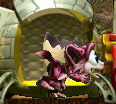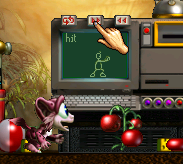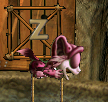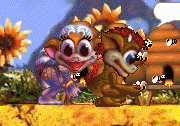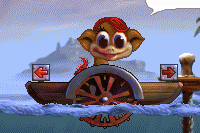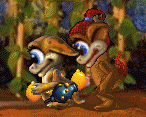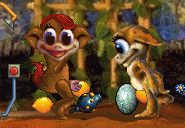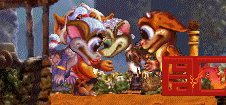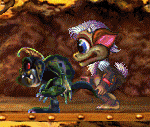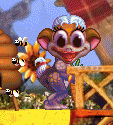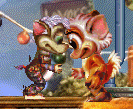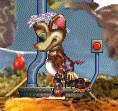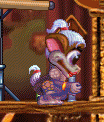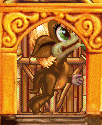Today I noticed that somewhere along the way I picked up a follower. I have no idea when this happened. I wasn't paying attention because I kind of didn't think anyone would actually want to read this! I probably should have put a little more thought into the URL if it's going to turn into a real blog. But thank you if you're visiting, and especially thanks to ArchDragon of The Arch for following!
Anyway, on to Creatures 2!
You can see just from looking at the Hatchery that C2 has a very different aesthetic than C1. Personally I prefer the warmer-toned steampunky look of the first game to the more sterile machinery that dominates in the second, but both games are lovely, especially for their time.
All six of these eggs contain Norns based on JayD's 10-Hour Nova Subterra genome and were created with Egg Maker. Unlike my first generation Norns in C1, I'm not editing their genetics aside from their appearance genes. There are a male and a female of each of the three base C2 breeds (Types H, I, and J). Their pigment and pigment bleed genes have been semi-randomized, so their colors will be a surprise!
After some deliberation, I decided to start with a female. I choose the plainest egg, the second from the left, to hatch first. After a few moments in the incubator, out popped a Creature far less plain than her egg, a little magenta Hebe with lime green eyes! I fell in love with her coloration the moment I saw her. I'm especially fond of her striking eye color. Unlike C1 Norns, C2 Norn eyes can vary drastically in color due to the effect of their new pigment bleed genes (although there is no specific gene for eye color).
Starting a very different naming trend than in my C1 game, I named the new Norn Darwin. I thought it was an appropriate choice! I led Darwin to the verb computer, and she proved to be a very quick learner, grasping all the verbs with only a couple repetitions. She was also a bit distractible, but who could blame her with a whole new world to explore? Her attention was stolen away several times by the various fruits and foods lying around the incubator area, a good sign for her future! As in C1, it's important to get your Creatures eating early in their life so they develop good habits.
Another major source of frustration in both games is convincing Norns they also need sleep, and I think that getting Norns to sleep is especially hard in C2. This was the reason I chose the Novas over the more popular Canny Norns. Both breeds are good and much, much smarter than the default Norns, but I find that Novas tend to be somewhat better sleepers (but worse breeders) than the Cannies. After some tossing and turning, Darwin managed to settle down for a nap. Hopefully she will keep this up well into adulthood!
Monday, October 10, 2011
Saturday, September 24, 2011
Begin at the Beginning, Again
I haven't been playing Creatures much lately. School has started back up, for one thing, but I've also been reluctant to play because I know that some of the older first generation Norns will probably pass away soon. I know that nature must take its course, as always, but perhaps taking a break from C1 will soften the blow when the inevitable arrives.
Creatures 2 is sort of the black sheep of the franchise. Graphically, it's a definite improvement, although honestly I have to say I prefer the old-timey look of the C1 world to the more sterile machinery that dominates large portions of C2. The C2 world is also much bigger and more varied, with rougher terrain and actua physics. C2 expanded on the concept of lifecycles for non-Creature objects, as introduced in the add-on Beelecanth Flower and Cloud Layer Butterfly for C1. A good portion of the plants and animals in the world grow, reproduce, and die, although many are also stationary to avoid catastrophic extinctions. There are seasons and a day/night cycle, but, unfortunately, the visual changes associated with those cycles are limited due to the technology of the time.
Gameplay-wise, there were also a few improvements. For one, "push" and "eat" are separate verbs. The vocabulary in C2 borders on being too large for my tastes, as I never get around to teaching any individual Creature all the words, but it's much smaller and more intuitive than in C3. Also, there's now a computer to teach Creatures emotion words without resorting to cheats. Creature genomes are more complicated and code for actual organs, which have their own life forces and can suffer damage individually. Also, the digestive system is much more complex and realistic. A Norn's life no longer depends almost solely on its glycogen level.
However, there was one enormous problem with C2 as it was shipped: the Norns were horribly broken. Due to a number of genetic bugs, the Norns would suffer from "One Hour Stupidity Syndrome," which caused them to suddenly become, well, stupid as they aged. By default, they also live shorter lives than in C2 -- about five hours as opposed to nine or ten. Even after an official update became available, most C2 players prefer to use a third-party genome. The two most commonly used genomes are the Canny Norns and the Nova Subterras.
Even with a new genome, C2 is the hardest of the three games. I've never been able to get into it quite like the first game, but it's never too late to try again! I'll be using the 10-Hour Nova Subterra genome by JayD and the Creatures Albian Years version of the game available from GOG.com. C2 is notorious for being the only Creatures game that won't run on Vista or Windows 7 in its original form, but I have been able to run the GOG version under Windows 7 with no problems by switching to 16-bit color before launching the game. By the way, when I run C1, I must run it as an administrator for it to work properly, but if I do that with C2, it just crashes, so make sure you try different combinations of settings when you're trying to get it to work.
Monday, September 5, 2011
Genetics Discussion: Wood Norns
The Wood Norns are a third party breed created years ago by legendary community member Frimlin. They can still be found at Treesprite's Creatures Grove if you'd like to have them in your game. In addition to their cute new appearance, these Norns have some genetic changes as well. Below is a comparison of Wood Norn genetics (top) and default hatchery Norn genetics (bottom).
Brain Lobes
121 6 0 Emb B MutDup Lobe #= 7 State Rule: state PLUS type0 <end> <end> <end> <end> <end>, WTA= 1
121 6 0 Emb B MutDup Lobe #= 7 State Rule: state PLUS type0 PLUS type1 <end> <end> <end>, WTA= 1
This is the same error present in the attention lobe of the Purple Mountain Norns. This should mean that the attention lobe fails to take into account information from the noun lobe, making the Norn incapable of making a connection between nouns spoken by the hand and objects they should look at in response. However, this error is corrected by the game executable itself and has no actual effect on the Creature. The Wood Norns were probably based on the hatchery Norns that shipped with the original UK version of the game, where this error originated.
Receptors
321 44 0 Sen B Creature, Somatic, die of old age, chem=Ageing, thresh=5, nom=117, gain=255, features=Inverted Digital
326 45 0 Emb B Creature, Circulatory, floating chem 2, chem=Glycogen, thresh=0, nom=0, gain=255, features=Analogue
These two new receptors are also present in the Life Kit breeds. The first is the die of old age gene, and the second is part of the updated hunger system in those Norns.
Emitters
327 28 0 Emb B MutDup Creature, Circulatory, floating chem 2, chem=Hunger, thresh=0, samp=5, gain=2, features=Inverted Analogue
Like the receptor genes, this new emitter is also a Life Kit gene. It goes with the glycogen receptor above and causes Norns to become hungry when their glycogen is low.
Reactions
71 13 0 Emb B MutDupCut 1*Pain-- + 1*Pain => 2*Reward + 1*<NONE>; half-life = 8.
71 13 0 Emb B MutDupCut 1*Pain-- + 1*Pain => 1*Reward + 1*<NONE>; half-life = 8.
72 14 0 Emb B MutDupCut 1*NFP-- + 2*NFP => 2*Reward + 1*<NONE>; half-life = 8.
72 14 0 Emb B MutDupCut 1*NFP-- + 1*NFP => 1*Reward + 1*<NONE>; half-life = 8.
73 15 0 Emb B MutDupCut 1*Hunger-- + 1*Hunger => 2*Reward + 1*<NONE>; half-life = 8.
73 15 0 Emb B MutDupCut 1*Hunger-- + 1*Hunger => 1*Reward + 1*<NONE>; half-life = 8.
74 16 0 Emb B MutDupCut 1*Coldness-- + 1*Coldness => 2*Reward + 1*<NONE>; half-life = 8.
74 16 0 Emb B MutDupCut 1*Coldness-- + 1*Coldness => 1*Reward + 1*<NONE>; half-life = 8.
75 17 0 Emb B MutDupCut 1*Hotness-- + 1*Hotness => 2*Reward + 1*<NONE>; half-life = 8.
75 17 0 Emb B MutDupCut 1*Hotness-- + 1*Hotness => 1*Reward + 1*<NONE>; half-life = 8.
76 18 0 Emb B MutDupCut 1*Tiredness-- + 1*Tiredness => 2*Reward + 1*<NONE>; half-life = 8.
76 18 0 Emb B MutDupCut 1*Tiredness-- + 1*Tiredness => 1*Reward + 1*<NONE>; half-life = 8.
78 19 0 Emb B MutDupCut 1*Sleepiness-- + 1*Sleepiness => 2*Reward + 1*<NONE>; half-life = 8.
78 19 0 Emb B MutDupCut 1*Sleepiness-- + 1*Sleepiness => 1*Reward + 1*<NONE>; half-life = 8.
79 20 0 Emb B MutDupCut 1*Loneliness-- + 1*Loneliness => 2*Reward + 1*<NONE>; half-life = 8.
79 20 0 Emb B MutDupCut 1*Loneliness-- + 1*Loneliness => 1*Reward + 1*<NONE>; half-life = 8.
80 21 0 Emb B MutDupCut 1*Crowdedness-- + 1*Crowdedness => 2*Reward + 1*<NONE>; half-life = 8.
80 21 0 Emb B MutDupCut 1*Crowdedness-- + 1*Crowdedness => 1*Reward + 1*<NONE>; half-life = 8.
82 22 0 Emb B MutDupCut 1*Fear-- + 1*Fear => 2*Reward + 1*<NONE>; half-life = 8.
82 22 0 Emb B MutDupCut 1*Fear-- + 1*Fear => 1*Reward + 1*<NONE>; half-life = 8.
84 23 0 Emb B MutDupCut 1*Boredom-- + 1*Boredom => 2*Reward + 1*<NONE>; half-life = 8.
84 23 0 Emb B MutDupCut 1*Boredom-- + 1*Boredom => 1*Reward + 1*<NONE>; half-life = 8.
85 24 0 Emb B MutDupCut 1*Anger-- + 1*Anger => 2*Reward + 1*<NONE>; half-life = 8.
85 24 0 Emb B MutDupCut 1*Anger-- + 1*Anger => 1*Reward + 1*<NONE>; half-life = 8.
86 33 0 Emb B MutDupCut 1*SexDrive-- + 1*SexDrive => 2*Reward + 1*<NONE>; half-life = 8.
86 33 0 Emb B MutDupCut 1*SexDrive-- + 1*SexDrive => 1*Reward + 1*<NONE>; half-life = 8.
All of these genes say basically the same thing: Wood Norns receive twice as much reward as regular Norns for reducing their drives. My two Wood Norns, Zelos and Seles, are both very cheerful as well as good eaters and sleepers. Zelos in particular tends to have an abnormally high life force. These genes may explain their behavior.
308 51 0 Emb B Mut 1*Hunger-- + 1*Hunger => 1*<NONE> + 1*<NONE>; half-life = 32.
This is a Purple Mountain gene. Like in the PMNs, this reaction is present in addition to the regular hunger reduction reaction. Their combination should mean that hunger decrease reduces the hunger drive more efficiently overall, but this gene doesn't produce any reward.
Stimuli
91 2 0 Emb B Mut 'Pointer pats me' causes sig=32 GS neu=0(I've been patted) int=255, , , Sensed Even When Asleep => 64*NFP-- + 16*Pain-- + 16*Loneliness-- + 30*Reward
91 2 0 Emb B Mut 'Pointer pats me' causes sig=32 GS neu=0(I've been patted) int=255, , , Sensed Even When Asleep => 64*NFP-- + 16*Pain-- + 16*Loneliness-- + 16*Reward
This is similar to the above reaction genes. When patted, Wood Norns gain almost twice as much reward as regular Norns. All of this together means that Wood Norns should learn good behaviors more quickly, although their punishment genes have been left unaltered.
Instincts
163 8 0 Ado B MutDupCut Drive i/ps SexDrive + General Sensory i/ps IT is opposite sex + (Lobe/Cell=0/0) and I Push => 207*Reward
163 8 0 Ado M MutDupCut Drive i/ps SexDrive + General Sensory i/ps IT is opposite sex + (Lobe/Cell=0/0) and I Push => 207*Reward
164 9 0 Ado B MutDupCut Drive i/ps SexDrive + General Sensory i/ps IT is opposite sex + (Lobe/Cell=0/0) and I Pull => 112*Reward
164 9 0 Ado M MutDupCut Drive i/ps SexDrive + General Sensory i/ps IT is opposite sex + (Lobe/Cell=0/0) and I Pull => 112*Reward
This is a very interesting change. This portion of the gene dictates whether it is sex-linked. In the standard Norn genome, only the males have the "courting" instinct to initiate mating. Wood Norns, however, are equal-opportunity kisspoppers, and either sex may court the other.
307 19 0 Emb B Attention seek o/ps Food + Drive i/ps Hunger + (Lobe/Cell=0/0) and I Push => 255*Reward
307 19 0 Emb B Stim source i/ps Food + Drive i/ps Hunger + (Lobe/Cell=0/0) and I Push => 255*Reward
This part of an instinct gene concerns the criteria that need to be met for the reward or punishment to be delivered. This gene normally relates to the stimulus source lobe. Cells in this lobe are fired by the presence of nearby objects. In the Wood Norn genome, however, this has been changed to the attention lobe, which is how Norns look at and recognize objects in their world. Wood Norns are rewarded if they look at food while hungry and then push (eat) it. Judging from the write-up on instinct genes at the Creatures Developer Resource, this is a more effective way to structure this instinct, as the stimulus source lobe is not a "perceptible" lobe and has no actual impact on the instinct gene. "Perceptible" lobes have their information copied to the perception lobe.
322 22 0 Emb B MutDupCut Drive i/ps Boredom + (Lobe/Cell=0/0) + (Lobe/Cell=0/0) and I Push => 129*Reward
323 23 0 Emb B MutDupCut Drive i/ps Boredom + (Lobe/Cell=0/0) + (Lobe/Cell=0/0) and I Pull => 156*Reward
These two new instinct genes reward the Norn for activating (pushing or pulling) when bored, encouraging them to do something instead of sitting around being bored.
324 24 0 Emb B MutDupCut Attention seek o/ps Food + (Lobe/Cell=0/0) + (Lobe/Cell=0/0) and I Push => 255*Reward
325 25 0 Emb B MutDupCut Attention seek o/ps Food + (Lobe/Cell=0/0) + (Lobe/Cell=0/0) and I Pull => 225*Reward
These final two instincts resemble gene 307 mentioned above, except without the condition of being hungry. Wood Norns are rewarded for pushing or pulling food even when they aren't hungry.
Brain Lobes
121 6 0 Emb B MutDup Lobe #= 7 State Rule: state PLUS type0 <end> <end> <end> <end> <end>, WTA= 1
121 6 0 Emb B MutDup Lobe #= 7 State Rule: state PLUS type0 PLUS type1 <end> <end> <end>, WTA= 1
This is the same error present in the attention lobe of the Purple Mountain Norns. This should mean that the attention lobe fails to take into account information from the noun lobe, making the Norn incapable of making a connection between nouns spoken by the hand and objects they should look at in response. However, this error is corrected by the game executable itself and has no actual effect on the Creature. The Wood Norns were probably based on the hatchery Norns that shipped with the original UK version of the game, where this error originated.
Receptors
321 44 0 Sen B Creature, Somatic, die of old age, chem=Ageing, thresh=5, nom=117, gain=255, features=Inverted Digital
326 45 0 Emb B Creature, Circulatory, floating chem 2, chem=Glycogen, thresh=0, nom=0, gain=255, features=Analogue
These two new receptors are also present in the Life Kit breeds. The first is the die of old age gene, and the second is part of the updated hunger system in those Norns.
Emitters
327 28 0 Emb B MutDup Creature, Circulatory, floating chem 2, chem=Hunger, thresh=0, samp=5, gain=2, features=Inverted Analogue
Like the receptor genes, this new emitter is also a Life Kit gene. It goes with the glycogen receptor above and causes Norns to become hungry when their glycogen is low.
Reactions
71 13 0 Emb B MutDupCut 1*Pain-- + 1*Pain => 2*Reward + 1*<NONE>; half-life = 8.
71 13 0 Emb B MutDupCut 1*Pain-- + 1*Pain => 1*Reward + 1*<NONE>; half-life = 8.
72 14 0 Emb B MutDupCut 1*NFP-- + 2*NFP => 2*Reward + 1*<NONE>; half-life = 8.
72 14 0 Emb B MutDupCut 1*NFP-- + 1*NFP => 1*Reward + 1*<NONE>; half-life = 8.
73 15 0 Emb B MutDupCut 1*Hunger-- + 1*Hunger => 2*Reward + 1*<NONE>; half-life = 8.
73 15 0 Emb B MutDupCut 1*Hunger-- + 1*Hunger => 1*Reward + 1*<NONE>; half-life = 8.
74 16 0 Emb B MutDupCut 1*Coldness-- + 1*Coldness => 2*Reward + 1*<NONE>; half-life = 8.
74 16 0 Emb B MutDupCut 1*Coldness-- + 1*Coldness => 1*Reward + 1*<NONE>; half-life = 8.
75 17 0 Emb B MutDupCut 1*Hotness-- + 1*Hotness => 2*Reward + 1*<NONE>; half-life = 8.
75 17 0 Emb B MutDupCut 1*Hotness-- + 1*Hotness => 1*Reward + 1*<NONE>; half-life = 8.
76 18 0 Emb B MutDupCut 1*Tiredness-- + 1*Tiredness => 2*Reward + 1*<NONE>; half-life = 8.
76 18 0 Emb B MutDupCut 1*Tiredness-- + 1*Tiredness => 1*Reward + 1*<NONE>; half-life = 8.
78 19 0 Emb B MutDupCut 1*Sleepiness-- + 1*Sleepiness => 2*Reward + 1*<NONE>; half-life = 8.
78 19 0 Emb B MutDupCut 1*Sleepiness-- + 1*Sleepiness => 1*Reward + 1*<NONE>; half-life = 8.
79 20 0 Emb B MutDupCut 1*Loneliness-- + 1*Loneliness => 2*Reward + 1*<NONE>; half-life = 8.
79 20 0 Emb B MutDupCut 1*Loneliness-- + 1*Loneliness => 1*Reward + 1*<NONE>; half-life = 8.
80 21 0 Emb B MutDupCut 1*Crowdedness-- + 1*Crowdedness => 2*Reward + 1*<NONE>; half-life = 8.
80 21 0 Emb B MutDupCut 1*Crowdedness-- + 1*Crowdedness => 1*Reward + 1*<NONE>; half-life = 8.
82 22 0 Emb B MutDupCut 1*Fear-- + 1*Fear => 2*Reward + 1*<NONE>; half-life = 8.
82 22 0 Emb B MutDupCut 1*Fear-- + 1*Fear => 1*Reward + 1*<NONE>; half-life = 8.
84 23 0 Emb B MutDupCut 1*Boredom-- + 1*Boredom => 2*Reward + 1*<NONE>; half-life = 8.
84 23 0 Emb B MutDupCut 1*Boredom-- + 1*Boredom => 1*Reward + 1*<NONE>; half-life = 8.
85 24 0 Emb B MutDupCut 1*Anger-- + 1*Anger => 2*Reward + 1*<NONE>; half-life = 8.
85 24 0 Emb B MutDupCut 1*Anger-- + 1*Anger => 1*Reward + 1*<NONE>; half-life = 8.
86 33 0 Emb B MutDupCut 1*SexDrive-- + 1*SexDrive => 2*Reward + 1*<NONE>; half-life = 8.
86 33 0 Emb B MutDupCut 1*SexDrive-- + 1*SexDrive => 1*Reward + 1*<NONE>; half-life = 8.
All of these genes say basically the same thing: Wood Norns receive twice as much reward as regular Norns for reducing their drives. My two Wood Norns, Zelos and Seles, are both very cheerful as well as good eaters and sleepers. Zelos in particular tends to have an abnormally high life force. These genes may explain their behavior.
308 51 0 Emb B Mut 1*Hunger-- + 1*Hunger => 1*<NONE> + 1*<NONE>; half-life = 32.
This is a Purple Mountain gene. Like in the PMNs, this reaction is present in addition to the regular hunger reduction reaction. Their combination should mean that hunger decrease reduces the hunger drive more efficiently overall, but this gene doesn't produce any reward.
Stimuli
91 2 0 Emb B Mut 'Pointer pats me' causes sig=32 GS neu=0(I've been patted) int=255, , , Sensed Even When Asleep => 64*NFP-- + 16*Pain-- + 16*Loneliness-- + 30*Reward
91 2 0 Emb B Mut 'Pointer pats me' causes sig=32 GS neu=0(I've been patted) int=255, , , Sensed Even When Asleep => 64*NFP-- + 16*Pain-- + 16*Loneliness-- + 16*Reward
This is similar to the above reaction genes. When patted, Wood Norns gain almost twice as much reward as regular Norns. All of this together means that Wood Norns should learn good behaviors more quickly, although their punishment genes have been left unaltered.
Instincts
163 8 0 Ado B MutDupCut Drive i/ps SexDrive + General Sensory i/ps IT is opposite sex + (Lobe/Cell=0/0) and I Push => 207*Reward
163 8 0 Ado M MutDupCut Drive i/ps SexDrive + General Sensory i/ps IT is opposite sex + (Lobe/Cell=0/0) and I Push => 207*Reward
164 9 0 Ado B MutDupCut Drive i/ps SexDrive + General Sensory i/ps IT is opposite sex + (Lobe/Cell=0/0) and I Pull => 112*Reward
164 9 0 Ado M MutDupCut Drive i/ps SexDrive + General Sensory i/ps IT is opposite sex + (Lobe/Cell=0/0) and I Pull => 112*Reward
This is a very interesting change. This portion of the gene dictates whether it is sex-linked. In the standard Norn genome, only the males have the "courting" instinct to initiate mating. Wood Norns, however, are equal-opportunity kisspoppers, and either sex may court the other.
307 19 0 Emb B Attention seek o/ps Food + Drive i/ps Hunger + (Lobe/Cell=0/0) and I Push => 255*Reward
307 19 0 Emb B Stim source i/ps Food + Drive i/ps Hunger + (Lobe/Cell=0/0) and I Push => 255*Reward
This part of an instinct gene concerns the criteria that need to be met for the reward or punishment to be delivered. This gene normally relates to the stimulus source lobe. Cells in this lobe are fired by the presence of nearby objects. In the Wood Norn genome, however, this has been changed to the attention lobe, which is how Norns look at and recognize objects in their world. Wood Norns are rewarded if they look at food while hungry and then push (eat) it. Judging from the write-up on instinct genes at the Creatures Developer Resource, this is a more effective way to structure this instinct, as the stimulus source lobe is not a "perceptible" lobe and has no actual impact on the instinct gene. "Perceptible" lobes have their information copied to the perception lobe.
322 22 0 Emb B MutDupCut Drive i/ps Boredom + (Lobe/Cell=0/0) + (Lobe/Cell=0/0) and I Push => 129*Reward
323 23 0 Emb B MutDupCut Drive i/ps Boredom + (Lobe/Cell=0/0) + (Lobe/Cell=0/0) and I Pull => 156*Reward
These two new instinct genes reward the Norn for activating (pushing or pulling) when bored, encouraging them to do something instead of sitting around being bored.
324 24 0 Emb B MutDupCut Attention seek o/ps Food + (Lobe/Cell=0/0) + (Lobe/Cell=0/0) and I Push => 255*Reward
325 25 0 Emb B MutDupCut Attention seek o/ps Food + (Lobe/Cell=0/0) + (Lobe/Cell=0/0) and I Pull => 225*Reward
These final two instincts resemble gene 307 mentioned above, except without the condition of being hungry. Wood Norns are rewarded for pushing or pulling food even when they aren't hungry.
Sunday, September 4, 2011
An Unexpected Egg and Other News
Although I've been forced to separate her from the others in the past, lately Seles has been doing very well socially! She still slaps more frequently and with more enthusiasm than is necessary, but she and Marta were able to pick and eat almost all the lemons on the lemon vine together in peace.
She was even present for the laying of Marta's egg, and seemed at least as surprised about the whole thing as the actual mother. I peeked at the genetics of the Norn inside, and, like all the second generation eggs aside from the first one, found no mutations that look worrying. Since most mutations are neutral at best, it's generally a relief to see that a Creature has no mutations that will affect its quality of life.
A short time later, I was surprised to see a new pregnancy listed in the Observation Kit, and even more surprised when I saw that the mother-to-be was Seles! I had almost given up on her, since her slapping has a tendency to kill the libido of any Norns in her company! I quick check with the D-DNA analyzer confirmed my suspicions that placid Emil was the male who was patient enough to withstand her attitude.
I missed the actual egg-laying, but later I found Seles's shiny blue egg in the garden! This brings the total number of second-generation eggs to twelve, with at least one egg by every first-generation Norn save one.
Meanwhile, Lloyd was out adventuring. Since he hasn't been hanging around the other Norns, he's missed out on playing a big role in the recent updates. With his tendency to travel when bored and hyperactive boredom emitter, he rarely spends an extended period of time in one place. He's spent quite some time playing with the mover below the garden and now is moving on to the area above the still.
Luckily, it looks like Lloyd's loner days are coming to a close, as he's met up with several of the female Norns near the wishing well. Elder females often retain some fertility, so there's always a chance some new eggs will come of this meeting! Also, as you can see, I've recently installed Freya's bridge cob. I'm hoping this will help my Norns travel around this area a little more efficiently.
Genis is the youngest first generation Norn and the only one who has yet to produce any eggs. The hatching of the first generation was quite widely spaced, and Genis is not quite three hours old, so there's still plenty of time. He has been hanging around in the same vicinity as Lloyd and the girls, but he seems to prefer amusing himself by playing with the lift in the lookout tower to playing with the others.
Saturday, September 3, 2011
Genetics Discussion: Ron Norns
"Ron-Norns have not been seen in Albia since Earth Year 1995. Ron was the original Norn, and amazingly the genetic code has survived and mutated since the original Ron. As with the Forest Norns, the male and female are different:
"Male: Ron-Norns have been around for a while, and have developed advanced 'fight or flight' genetic codes, giving them the edge against Grendel attacks.
"Female: The female Ron-Norns have a tendency to get very angry when surprised or frightened."
The Ron Norns were the final genetically differentiated breed included with the C1 Life Kit. They are based on the original Norn design. As mentioned in their blurb, this is also supposedly where they got their name, after the first Norn. (Admittedly, it seems even more mundane than Adam.) As you may have noticed, none of my Norns have Ron sprites. They look perfectly fine in-game, but I simply prefer the other breeds' appearances. However, what really makes Rons unique is a suite of genes that give them a "fight-or-flight" (ForF) response to encounters with other Creatures. I find these especially interesting and have commented in previous posts on the variations present in my Norns and my observations of their effects.
Anyway, this post is organized slightly differently than the other breed discussions. Instead of dividing the changes by gene type, I've categorized them as "fight," "flight," or other genes. The Ron genes are listed above the equivalent gene from the standard hatchery genome. Genes listed singly are new to the Ron breed.
Non-Fight-or-Flight Genes
Like the other Life Kit Norns, the Ron genome includes reactions for the dancing chemical and the poison geddonase. Ron Norns also share their altered hunger production system (the hunger emitter/glycogen receptor pair) with the Forest Norns. They have the same new instinct (regarding weeds and herbs) and altered stimulus (regarding being patted, seeing objects, and hearing new words) genes as the Forest Norns. Again like other Life Kit Norns, they are rewarded for sleeping when sleepy, instead of only when they are tired.
In addition, there are two more altered genes I'd like to point out:
62 6 0 Emb B MutDupCut 1*Tiredness++ + 1*<NONE> => 1*Tiredness + 1*<NONE>; half-life = 8.
62 6 0 Emb B MutDupCut 1*Tiredness++ + 1*<NONE> => 1*Tiredness + 1*Punishment; half-life = 8.
64 7 0 Emb B MutDupCut 1*Sleepiness++ + 1*<NONE> => 1*Sleepiness + 1*<NONE>; half-life = 8.
64 7 0 Emb B MutDupCut 1*Sleepiness++ + 1*<NONE> => 1*Sleepiness + 1*Punishment; half-life = 8.
Do these genes look familiar? They should -- they were also present in the Forest Norn genome. These changes mean that Ron Norns are not punished for getting tired or sleepy, which is logical because, unlike drives like pain, they have little control over these. Why am I reprinting them? Because these are the only two drives altered in the Ron genome. In Forest Norns, the reactions for need for pleasure (NFP), boredom, and hunger increase have been altered similarly. I find it puzzling that Ron Norns lack those three changes, but not the two above.
The half-life gene of the Ron breed is slightly different from that of the Forest, but not meaningfully so: the chemical numbers concerned are all unused.
Fight Genes
336 65 0 Emb B MutDupCut 1*Fear + 1*Turnase => 1*Anger + 1*<NONE>; half-life = 32.
This is the reaction for one of the two new chemicals that govern the ForF response. Turnase is a catalyst that converts fear into anger. When Turnase is produced, the Norn becomes less frightened and more angry. Coupled with the below reactions, this turns fleeing into fighting.
95 6 0 Emb B Mut 'It is approaching' causes sig=82 GS neu=10(IT is approaching) int=255, , , => 31*Turnase + 0*<NONE> + 0*<NONE> + 0*<NONE>
95 6 0 Emb B Mut 'It is approaching' causes sig=82 GS neu=10(IT is approaching) int=255, , , => 0*<NONE> + 0*<NONE> + 0*<NONE> + 0*<NONE>
97 8 0 Emb B Mut 'I bump into wall' causes sig=0 GS neu=2(I've bumped a wall) int=255, , , Sensed Even When Asleep => 25*Pain++ + 127*Turnase + 0*<NONE> + 0*<NONE>
97 8 0 Emb B Mut 'I bump into wall' causes sig=0 GS neu=2(I've bumped a wall) int=255, , , Sensed Even When Asleep => 25*Pain++ + 0*<NONE> + 0*<NONE> + 0*<NONE>
These two altered stimulus reactions govern the production of Turnase. The first causes turnase to be produced when a Creature -- a potential threat -- approaches the Norn. The second actives when the Norn wallbonks, or walks into a wall. This is how the Norn determines it's been cornered and the reason that Norns with the ForF genes slap more frequently in closed spaces.
333 31 0 Emb B MutDupCut Drive i/ps Anger + General Sensory i/ps IT is a creature + General Sensory i/ps IT is approaching and I Stop => 255*Reward
334 32 0 Emb B MutDupCut Drive i/ps Anger + General Sensory i/ps IT is an object + General Sensory i/ps IT is approaching and I Push => 255*Reward
These two instinct genes are the actual "fight" genes. When the Norn is angry, it is rewarded for pushing objects and hitting other Creatures, which may be the source of its frustration.
96 7 0 Emb B Mut 'It is retreating' causes sig=36 GS neu=11(IT is retreating) int=255, , , => 3*Fear-- + 3*Anger-- + 0*<NONE> + 0*<NONE>
96 7 0 Emb B Mut 'It is retreating' causes sig=36 GS neu=11(IT is retreating) int=255, , , => 0*<NONE> + 0*<NONE> + 0*<NONE> + 0*<NONE>
This gene causes fear and anger to be reduced when the other Creature retreats, either because it was scared off or because it spotted something more interesting. This, coupled with the fact that moving around reduces stress, fear, and anger, causes the Norn to "cool off" after the ForF reaction is engaged.
Flight Genes
337 66 0 Emb B MutDupCut 1*Anger + 1*Collapsase => 1*Fear + 1*<NONE>; half-life = 32.
This is the reaction for the other new chemical, the especially-oddly-named Collapsase. Collapsase is exactly the inverse of Turnase, converting anger to fear. This provokes the flight response.
335 127 0 Emb B Mut 'I have retreated' causes sig=0 GS neu=255 int=0, , , => 127*Collapsase + 0*<NONE> + 0*<NONE> + 0*<NONE>
This is the novel stimulus gene that causes Collapsase to be produced. Interestingly, this only happens when the Norn itself is retreating, and not at other times one may expect -- like when it is slapped or injured.
332 30 0 Emb B MutDupCut Drive i/ps Fear + General Sensory i/ps IT is approaching + (Lobe/Cell=0/0) and I Run => 255*Reward
As above, this is the actual "flight" gene. This instinct gene encourages the Norn to flee when frightened.
All Norns become frightened and angry when slapped. The ForF genes, taken together, form a system where a Norn may go from one to the other according to their circumstances. However, I suspect there is a flaw in this system, and that Rons are biased toward fighting, perhaps by design as that is a very conspicuous behavior. Notice that there are more genes concerned with fighting, and, most importantly, that there is only one stimulus that produces Collapsase, and that stimulus (retreating) is called by the Norn's actions, not an external source (like another Creature). Anecdotally, I will report that, while several of my Norns have these genes, and the only one in whom I have observed an obvious tendency to flee from others is Emil, who lacks all the genes listed above in the "fight" section.
The "I've been slapped" stimulus gene, by default, creates more fear than anger, which is one possible reason for this setup. Having the stimulus also produce Collapsase may be overkill, skewing the reactions in the other direction. As it stands, I think the production of Turnase may have a tendency to swamp out Collapsase. Something to investigate.
I suspect this system could be better balanced by the inclusion of the pain drive in the equation, possibly in a way similar to Zelos's novel emitter, which produces Turnase when pain levels increase above a certain level. With an emitter like this, it seems like the production of Collapsase in response to slapping may be more viable, because it would be balanced (and eventually overwhelmed) by the eventual production of Turnase when pain levels reach that threshold.
You know, in retrospect, I wish I'd been an adult when this game was first released! Discussing this at the height of the Creatures Community would have been great.
I have one more point to make: as in the Forest breed, none of the new or altered genes are sex-linked. Therefore, male and female Rons should not be any more systemically different from each other than males and females of other breeds.
"Male: Ron-Norns have been around for a while, and have developed advanced 'fight or flight' genetic codes, giving them the edge against Grendel attacks.
"Female: The female Ron-Norns have a tendency to get very angry when surprised or frightened."
The Ron Norns were the final genetically differentiated breed included with the C1 Life Kit. They are based on the original Norn design. As mentioned in their blurb, this is also supposedly where they got their name, after the first Norn. (Admittedly, it seems even more mundane than Adam.) As you may have noticed, none of my Norns have Ron sprites. They look perfectly fine in-game, but I simply prefer the other breeds' appearances. However, what really makes Rons unique is a suite of genes that give them a "fight-or-flight" (ForF) response to encounters with other Creatures. I find these especially interesting and have commented in previous posts on the variations present in my Norns and my observations of their effects.
Anyway, this post is organized slightly differently than the other breed discussions. Instead of dividing the changes by gene type, I've categorized them as "fight," "flight," or other genes. The Ron genes are listed above the equivalent gene from the standard hatchery genome. Genes listed singly are new to the Ron breed.
Non-Fight-or-Flight Genes
Like the other Life Kit Norns, the Ron genome includes reactions for the dancing chemical and the poison geddonase. Ron Norns also share their altered hunger production system (the hunger emitter/glycogen receptor pair) with the Forest Norns. They have the same new instinct (regarding weeds and herbs) and altered stimulus (regarding being patted, seeing objects, and hearing new words) genes as the Forest Norns. Again like other Life Kit Norns, they are rewarded for sleeping when sleepy, instead of only when they are tired.
In addition, there are two more altered genes I'd like to point out:
62 6 0 Emb B MutDupCut 1*Tiredness++ + 1*<NONE> => 1*Tiredness + 1*<NONE>; half-life = 8.
62 6 0 Emb B MutDupCut 1*Tiredness++ + 1*<NONE> => 1*Tiredness + 1*Punishment; half-life = 8.
64 7 0 Emb B MutDupCut 1*Sleepiness++ + 1*<NONE> => 1*Sleepiness + 1*<NONE>; half-life = 8.
64 7 0 Emb B MutDupCut 1*Sleepiness++ + 1*<NONE> => 1*Sleepiness + 1*Punishment; half-life = 8.
The half-life gene of the Ron breed is slightly different from that of the Forest, but not meaningfully so: the chemical numbers concerned are all unused.
Fight Genes
336 65 0 Emb B MutDupCut 1*Fear + 1*Turnase => 1*Anger + 1*<NONE>; half-life = 32.
This is the reaction for one of the two new chemicals that govern the ForF response. Turnase is a catalyst that converts fear into anger. When Turnase is produced, the Norn becomes less frightened and more angry. Coupled with the below reactions, this turns fleeing into fighting.
95 6 0 Emb B Mut 'It is approaching' causes sig=82 GS neu=10(IT is approaching) int=255, , , => 31*Turnase + 0*<NONE> + 0*<NONE> + 0*<NONE>
95 6 0 Emb B Mut 'It is approaching' causes sig=82 GS neu=10(IT is approaching) int=255, , , => 0*<NONE> + 0*<NONE> + 0*<NONE> + 0*<NONE>
97 8 0 Emb B Mut 'I bump into wall' causes sig=0 GS neu=2(I've bumped a wall) int=255, , , Sensed Even When Asleep => 25*Pain++ + 127*Turnase + 0*<NONE> + 0*<NONE>
97 8 0 Emb B Mut 'I bump into wall' causes sig=0 GS neu=2(I've bumped a wall) int=255, , , Sensed Even When Asleep => 25*Pain++ + 0*<NONE> + 0*<NONE> + 0*<NONE>
These two altered stimulus reactions govern the production of Turnase. The first causes turnase to be produced when a Creature -- a potential threat -- approaches the Norn. The second actives when the Norn wallbonks, or walks into a wall. This is how the Norn determines it's been cornered and the reason that Norns with the ForF genes slap more frequently in closed spaces.
333 31 0 Emb B MutDupCut Drive i/ps Anger + General Sensory i/ps IT is a creature + General Sensory i/ps IT is approaching and I Stop => 255*Reward
334 32 0 Emb B MutDupCut Drive i/ps Anger + General Sensory i/ps IT is an object + General Sensory i/ps IT is approaching and I Push => 255*Reward
These two instinct genes are the actual "fight" genes. When the Norn is angry, it is rewarded for pushing objects and hitting other Creatures, which may be the source of its frustration.
96 7 0 Emb B Mut 'It is retreating' causes sig=36 GS neu=11(IT is retreating) int=255, , , => 3*Fear-- + 3*Anger-- + 0*<NONE> + 0*<NONE>
96 7 0 Emb B Mut 'It is retreating' causes sig=36 GS neu=11(IT is retreating) int=255, , , => 0*<NONE> + 0*<NONE> + 0*<NONE> + 0*<NONE>
This gene causes fear and anger to be reduced when the other Creature retreats, either because it was scared off or because it spotted something more interesting. This, coupled with the fact that moving around reduces stress, fear, and anger, causes the Norn to "cool off" after the ForF reaction is engaged.
Flight Genes
337 66 0 Emb B MutDupCut 1*Anger + 1*Collapsase => 1*Fear + 1*<NONE>; half-life = 32.
This is the reaction for the other new chemical, the especially-oddly-named Collapsase. Collapsase is exactly the inverse of Turnase, converting anger to fear. This provokes the flight response.
335 127 0 Emb B Mut 'I have retreated' causes sig=0 GS neu=255 int=0, , , => 127*Collapsase + 0*<NONE> + 0*<NONE> + 0*<NONE>
This is the novel stimulus gene that causes Collapsase to be produced. Interestingly, this only happens when the Norn itself is retreating, and not at other times one may expect -- like when it is slapped or injured.
332 30 0 Emb B MutDupCut Drive i/ps Fear + General Sensory i/ps IT is approaching + (Lobe/Cell=0/0) and I Run => 255*Reward
As above, this is the actual "flight" gene. This instinct gene encourages the Norn to flee when frightened.
All Norns become frightened and angry when slapped. The ForF genes, taken together, form a system where a Norn may go from one to the other according to their circumstances. However, I suspect there is a flaw in this system, and that Rons are biased toward fighting, perhaps by design as that is a very conspicuous behavior. Notice that there are more genes concerned with fighting, and, most importantly, that there is only one stimulus that produces Collapsase, and that stimulus (retreating) is called by the Norn's actions, not an external source (like another Creature). Anecdotally, I will report that, while several of my Norns have these genes, and the only one in whom I have observed an obvious tendency to flee from others is Emil, who lacks all the genes listed above in the "fight" section.
The "I've been slapped" stimulus gene, by default, creates more fear than anger, which is one possible reason for this setup. Having the stimulus also produce Collapsase may be overkill, skewing the reactions in the other direction. As it stands, I think the production of Turnase may have a tendency to swamp out Collapsase. Something to investigate.
I suspect this system could be better balanced by the inclusion of the pain drive in the equation, possibly in a way similar to Zelos's novel emitter, which produces Turnase when pain levels increase above a certain level. With an emitter like this, it seems like the production of Collapsase in response to slapping may be more viable, because it would be balanced (and eventually overwhelmed) by the eventual production of Turnase when pain levels reach that threshold.
You know, in retrospect, I wish I'd been an adult when this game was first released! Discussing this at the height of the Creatures Community would have been great.
I have one more point to make: as in the Forest breed, none of the new or altered genes are sex-linked. Therefore, male and female Rons should not be any more systemically different from each other than males and females of other breeds.
Friday, September 2, 2011
Update on the Aged
 Lately, Mithos has been spending a great deal of time with some of the Norns in the area near the cannon. I've found him to be, if anything, more obedient than my Norns, which is surprising as Grendels lack instincts to obey the hand. I'm trying to keep a closer eye on him using the Grendel Selector, as his age and the fact that he doesn't appear in the Observation Kit are cause for concern.
Lately, Mithos has been spending a great deal of time with some of the Norns in the area near the cannon. I've found him to be, if anything, more obedient than my Norns, which is surprising as Grendels lack instincts to obey the hand. I'm trying to keep a closer eye on him using the Grendel Selector, as his age and the fact that he doesn't appear in the Observation Kit are cause for concern.In my game, I've replaced the default Grendel genetics. Mithos and other Grendels born in my Albia are able to breed and have several genes from the Ron Norn breed, including the flight-or-fight genes and the new instincts. They also have the die-of-old-age gene. They are based on the many-colored Grendel genetics created by Slink.
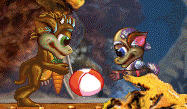 Things have been peaceful for the elders of Albia recently. Kratos and Regal, the two firstborn of this generation, seem to have retired permanently to the island, specifically the middle level where it's easiest to watch the sealife. Regal makes occasional trips across the sea in the cart to visit the other Norns, but he always returns to the quiet of the island in the end.
Things have been peaceful for the elders of Albia recently. Kratos and Regal, the two firstborn of this generation, seem to have retired permanently to the island, specifically the middle level where it's easiest to watch the sealife. Regal makes occasional trips across the sea in the cart to visit the other Norns, but he always returns to the quiet of the island in the end. Of course, Kratos has already spent most of his life on he island! At almost ten hours old, his health has started to worry me. Elder Norns often become stubborn eaters. This is made even more frustrating by Kratos's ever-present reluctance to listen my suggestions to eat and sleep. My paranoia is exacerbating my growing dread that the oldest first generation Norns will soon pass on.
Of course, Kratos has already spent most of his life on he island! At almost ten hours old, his health has started to worry me. Elder Norns often become stubborn eaters. This is made even more frustrating by Kratos's ever-present reluctance to listen my suggestions to eat and sleep. My paranoia is exacerbating my growing dread that the oldest first generation Norns will soon pass on.But none of the elders are showing any sign of slowing down! Here are Raine and Presea in the latter's favorite spot between the outlook and cliff. Although they are both elders, notice how much Raine has shrunk! The Life Kit breeds become smaller in their old age, which can make mixed-breed elder Norns look a little odd. Raine seems to have been a good influence on Presea, who is finally eating on occasion before her life force drops into the 50s.
Norns with the die-of-old-age gene live about ten to twelve hours. Although I consider myself a generally logical and scientifically-minded person, I can't help but get attached to my little digital pets. Although they aren't literally alive,
Friday, August 26, 2011
Gen 1 Genetics Overview: Females
This is a continuation of my discussion of the genetic changes made to the first generation Norns in my current game of C1. The males were discussed here.
Presea has a few genetic changes that, I think, must have contributed to her loner nature. Upon closer inspection of this picture, I feel compelled to mention that I don't think there are genes for getting cheese stuck to you! I wish she would eat it instead of getting it glitchily (?) attached to her legs!
140 9 0 Emb B MutDupCut Creature, Sensorimotor, Crowdedness, chem=Loneliness, thresh=0, samp=22, gain=2, features=Inverted Analogue
140 9 0 Emb B MutDupCut Creature, Sensorimotor, Crowdedness, chem=Loneliness, thresh=0, samp=18, gain=5, features=Inverted Analogue
141 10 0 Emb B MutDupCut Creature, Sensorimotor, Crowdedness, chem=Crowdedness, thresh=0, samp=71, gain=59, features=Analogue
141 10 0 Emb B MutDupCut Creature, Sensorimotor, Crowdedness, chem=Crowdedness, thresh=0, samp=75, gain=51, features=Analogue
The changes made to Presea's emitter genes follow the same pattern as Lloyd's, but with different drives. Presea becomes lonely more slowly than normal and crowded more quickly.
Raine is a completely normal, unaltered Forest Norn. I have actually found her to be a worse eater than some of the others, although she is basically always obedient when I tell her to eat. Still, I find it surprising that the Forest Norn genes don't seem to stand out more in the game.
Sheena looks like a Purple Mountain Norn, but don't be fooled. Her genetics are actually completely Ron Norn. This means that she has the Ron ForF genes as well as the altered glycogen/glucose/hunger system from both the Life Kit breeds. She is exceptionally cheerful and has always been a good eater and sleeper. She slaps a little more than is necessary, but I suspect that's a combination of the ForF genes and the small spaces that make up a great deal of Albia.
Colette, meanwhile, is a Horse Norn with several changes to reflect my first generation theme.
249 36 0 Chi B MutDupCut Creature, Sensorimotor, angry, chem=Anger, thresh=136, nom=0, gain=223, features=Analogue
249 36 0 Chi B MutDupCut Creature, Sensorimotor, angry, chem=Anger, thresh=128, nom=0, gain=239, features=Analogue
Colette has to reach a high threshold of anger before she expresses it. However, C1 Norns almost never express their anger as it is.
71 13 0 Emb B MutDupCut 1*Pain-- + 2*Pain => 1*Reward + 1*<NONE>; half-life = 8.
71 13 0 Emb B MutDupCut 1*Pain-- + 1*Pain => 1*Reward + 1*<NONE>; half-life = 8.
In Colette's system, pain decrease reactions with 2 pain instead of 1, reducing pain more effectively.
112 26 0 Emb B MutDup 1*Punishment + 1*<NONE> => 1*Reinforcement + 2*PunishmentEcho; half-life = 16.
112 26 0 Emb B MutDup 1*Punishment + 1*<NONE> => 1*Reinforcement + 1*PunishmentEcho; half-life = 16.
A Norn's learning is governed by the Reward and Punishment chemicals. These chemicals are very short-lived. They decay into Reward Echo and Punishment Echo, which are longer-lasting. Colette receives twice as much Punishment Echo for the amount of Punishment in her system than normal. I thought she may learn not to do bad behaviors more quickly than normal, but since she's basically always good, I don't think this change has influenced much.
90 1 1 0 Emb B Mut 'Disappointment' causes sig=0 GS neu=255 int=0, , , => 16*Boredom++ + 16*NFP++ + 8*Anger++ + 0*<NONE>
90 1 0 Emb B Mut 'Disappointment' causes sig=0 GS neu=255 int=0, , , => 16*Boredom++ + 16*NFP++ + 16*Anger++ + 0*<NONE>
93 4 0 Emb B Mut 'Pointer slaps me' causes sig=32 GS neu=1(I've been slapped) int=255, , , Sensed Even When Asleep => 75*Pain++ + 32*Fear++ + 8*Anger++ + 16*Sleepiness--
93 4 0 Emb B Mut 'Pointer slaps me' causes sig=32 GS neu=1(I've been slapped) int=255, , , Sensed Even When Asleep => 75*Pain++ + 32*Fear++ + 16*Anger++ + 16*Sleepiness--
94 5 0 Emb B Mut 'Creature slaps me' causes sig=128 GS neu=1(I've been slapped) int=255, , , Sensed Even When Asleep => 80*Pain++ + 32*Fear++ + 8*Anger++ + 16*Sleepiness--
94 5 0 Emb B Mut 'Creature slaps me' causes sig=128 GS neu=1(I've been slapped) int=255, , , Sensed Even When Asleep => 80*Pain++ + 32*Fear++ + 16*Anger++ + 16*Sleepiness--
These stimulus changes all go together. Colette becomes less angry than normal when disappointed or slapped, either by the hand or another creature.
Seles is our current problem child! No, actually, she hasn't been much of a problem lately. She does much better in open spaces, like the garden, and I keep her away from Norns that I want to breed. Maybe having a Norn like Seles around could be an effective form of population control?
As I've said before, Seles is a normal Wood Norn with the "fight" ForF genes from the Ron genome.
Marta is the final first generation female.
91 2 0 Emb B Mut 'Pointer pats me' causes sig=32 GS neu=0(I've been patted) int=255, , , Sensed Even When Asleep => 96*NFP-- + 16*Pain-- + 16*Loneliness-- + 16*Reward
91 2 0 Emb B Mut 'Pointer pats me' causes sig=32 GS neu=0(I've been patted) int=255, , , Sensed Even When Asleep => 64*NFP-- + 16*Pain-- + 16*Loneliness-- + 16*Reward
92 3 0 Emb B Mut 'Creature pats me' causes sig=80 GS neu=0(I've been patted) int=255, , , Sensed Even When Asleep => 80*NFP-- + 16*Loneliness-- + 31*Crowdedness++ + 8*<NONE>
92 3 0 Emb B Mut 'Creature pats me' causes sig=80 GS neu=0(I've been patted) int=255, , , Sensed Even When Asleep => 48*NFP-- + 16*Loneliness-- + 31*Crowdedness++ + 8*<NONE>
101 12 0 Emb B Mut 'Heard creature speak' causes sig=16 GS neu=6(Creature has spoken) int=175, , , Sensed Even When Asleep => 48*Boredom-- + 32*Loneliness-- + 12*Crowdedness++ + 0*<NONE>
101 12 0 Emb B Mut 'Heard creature speak' causes sig=16 GS neu=6(Creature has spoken) int=175, , , Sensed Even When Asleep => 16*Boredom-- + 16*Loneliness-- + 16*Crowdedness++ + 0*<NONE>
Marta gets considerably more pleasure out of interacting with others than normal. Actually, I'm sort of surprised that I made these changes so huge. I must have gotten click-happy in the Genetics Kit. Maybe that explains why her personality is so noticeably different in-game!
328 20 0 Emb B MutDupCut Drive i/ps Boredom + General Sensory i/ps IT is a creature + (Lobe/Cell=0/0) and I Come => 128*Reward
This is a new instinct that rewards Marta for approaching other Creatures when bored. So, not only does she get more enjoyment out of being around others, she prefers social interactions to other activities when bored.
There's also a bit of exciting news to report! I played a short time in order to take these pictures, and right before I closed the game, I was alerted to a pregnancy by the Observation Kit! I found Marta and Emil in the kitchen -- she'd gone back to her nap, and he was doing his best to look innocent! There had been such a long lull in egg laying that I'd started encouraging my Norns to breed, something I generally don't find necessary, but these two were unsuccessful... until I turned my back for ten minutes! They weren't even together last I'd seen them!
Presea has a few genetic changes that, I think, must have contributed to her loner nature. Upon closer inspection of this picture, I feel compelled to mention that I don't think there are genes for getting cheese stuck to you! I wish she would eat it instead of getting it glitchily (?) attached to her legs!
140 9 0 Emb B MutDupCut Creature, Sensorimotor, Crowdedness, chem=Loneliness, thresh=0, samp=22, gain=2, features=Inverted Analogue
140 9 0 Emb B MutDupCut Creature, Sensorimotor, Crowdedness, chem=Loneliness, thresh=0, samp=18, gain=5, features=Inverted Analogue
141 10 0 Emb B MutDupCut Creature, Sensorimotor, Crowdedness, chem=Crowdedness, thresh=0, samp=71, gain=59, features=Analogue
141 10 0 Emb B MutDupCut Creature, Sensorimotor, Crowdedness, chem=Crowdedness, thresh=0, samp=75, gain=51, features=Analogue
The changes made to Presea's emitter genes follow the same pattern as Lloyd's, but with different drives. Presea becomes lonely more slowly than normal and crowded more quickly.
Raine is a completely normal, unaltered Forest Norn. I have actually found her to be a worse eater than some of the others, although she is basically always obedient when I tell her to eat. Still, I find it surprising that the Forest Norn genes don't seem to stand out more in the game.
Sheena looks like a Purple Mountain Norn, but don't be fooled. Her genetics are actually completely Ron Norn. This means that she has the Ron ForF genes as well as the altered glycogen/glucose/hunger system from both the Life Kit breeds. She is exceptionally cheerful and has always been a good eater and sleeper. She slaps a little more than is necessary, but I suspect that's a combination of the ForF genes and the small spaces that make up a great deal of Albia.
Colette, meanwhile, is a Horse Norn with several changes to reflect my first generation theme.
249 36 0 Chi B MutDupCut Creature, Sensorimotor, angry, chem=Anger, thresh=136, nom=0, gain=223, features=Analogue
249 36 0 Chi B MutDupCut Creature, Sensorimotor, angry, chem=Anger, thresh=128, nom=0, gain=239, features=Analogue
Colette has to reach a high threshold of anger before she expresses it. However, C1 Norns almost never express their anger as it is.
71 13 0 Emb B MutDupCut 1*Pain-- + 2*Pain => 1*Reward + 1*<NONE>; half-life = 8.
71 13 0 Emb B MutDupCut 1*Pain-- + 1*Pain => 1*Reward + 1*<NONE>; half-life = 8.
In Colette's system, pain decrease reactions with 2 pain instead of 1, reducing pain more effectively.
112 26 0 Emb B MutDup 1*Punishment + 1*<NONE> => 1*Reinforcement + 2*PunishmentEcho; half-life = 16.
112 26 0 Emb B MutDup 1*Punishment + 1*<NONE> => 1*Reinforcement + 1*PunishmentEcho; half-life = 16.
A Norn's learning is governed by the Reward and Punishment chemicals. These chemicals are very short-lived. They decay into Reward Echo and Punishment Echo, which are longer-lasting. Colette receives twice as much Punishment Echo for the amount of Punishment in her system than normal. I thought she may learn not to do bad behaviors more quickly than normal, but since she's basically always good, I don't think this change has influenced much.
90 1 1 0 Emb B Mut 'Disappointment' causes sig=0 GS neu=255 int=0, , , => 16*Boredom++ + 16*NFP++ + 8*Anger++ + 0*<NONE>
90 1 0 Emb B Mut 'Disappointment' causes sig=0 GS neu=255 int=0, , , => 16*Boredom++ + 16*NFP++ + 16*Anger++ + 0*<NONE>
93 4 0 Emb B Mut 'Pointer slaps me' causes sig=32 GS neu=1(I've been slapped) int=255, , , Sensed Even When Asleep => 75*Pain++ + 32*Fear++ + 8*Anger++ + 16*Sleepiness--
93 4 0 Emb B Mut 'Pointer slaps me' causes sig=32 GS neu=1(I've been slapped) int=255, , , Sensed Even When Asleep => 75*Pain++ + 32*Fear++ + 16*Anger++ + 16*Sleepiness--
94 5 0 Emb B Mut 'Creature slaps me' causes sig=128 GS neu=1(I've been slapped) int=255, , , Sensed Even When Asleep => 80*Pain++ + 32*Fear++ + 8*Anger++ + 16*Sleepiness--
94 5 0 Emb B Mut 'Creature slaps me' causes sig=128 GS neu=1(I've been slapped) int=255, , , Sensed Even When Asleep => 80*Pain++ + 32*Fear++ + 16*Anger++ + 16*Sleepiness--
These stimulus changes all go together. Colette becomes less angry than normal when disappointed or slapped, either by the hand or another creature.
Seles is our current problem child! No, actually, she hasn't been much of a problem lately. She does much better in open spaces, like the garden, and I keep her away from Norns that I want to breed. Maybe having a Norn like Seles around could be an effective form of population control?
As I've said before, Seles is a normal Wood Norn with the "fight" ForF genes from the Ron genome.
Marta is the final first generation female.
91 2 0 Emb B Mut 'Pointer pats me' causes sig=32 GS neu=0(I've been patted) int=255, , , Sensed Even When Asleep => 96*NFP-- + 16*Pain-- + 16*Loneliness-- + 16*Reward
91 2 0 Emb B Mut 'Pointer pats me' causes sig=32 GS neu=0(I've been patted) int=255, , , Sensed Even When Asleep => 64*NFP-- + 16*Pain-- + 16*Loneliness-- + 16*Reward
92 3 0 Emb B Mut 'Creature pats me' causes sig=80 GS neu=0(I've been patted) int=255, , , Sensed Even When Asleep => 80*NFP-- + 16*Loneliness-- + 31*Crowdedness++ + 8*<NONE>
92 3 0 Emb B Mut 'Creature pats me' causes sig=80 GS neu=0(I've been patted) int=255, , , Sensed Even When Asleep => 48*NFP-- + 16*Loneliness-- + 31*Crowdedness++ + 8*<NONE>
101 12 0 Emb B Mut 'Heard creature speak' causes sig=16 GS neu=6(Creature has spoken) int=175, , , Sensed Even When Asleep => 48*Boredom-- + 32*Loneliness-- + 12*Crowdedness++ + 0*<NONE>
101 12 0 Emb B Mut 'Heard creature speak' causes sig=16 GS neu=6(Creature has spoken) int=175, , , Sensed Even When Asleep => 16*Boredom-- + 16*Loneliness-- + 16*Crowdedness++ + 0*<NONE>
Marta gets considerably more pleasure out of interacting with others than normal. Actually, I'm sort of surprised that I made these changes so huge. I must have gotten click-happy in the Genetics Kit. Maybe that explains why her personality is so noticeably different in-game!
328 20 0 Emb B MutDupCut Drive i/ps Boredom + General Sensory i/ps IT is a creature + (Lobe/Cell=0/0) and I Come => 128*Reward
This is a new instinct that rewards Marta for approaching other Creatures when bored. So, not only does she get more enjoyment out of being around others, she prefers social interactions to other activities when bored.
There's also a bit of exciting news to report! I played a short time in order to take these pictures, and right before I closed the game, I was alerted to a pregnancy by the Observation Kit! I found Marta and Emil in the kitchen -- she'd gone back to her nap, and he was doing his best to look innocent! There had been such a long lull in egg laying that I'd started encouraging my Norns to breed, something I generally don't find necessary, but these two were unsuccessful... until I turned my back for ten minutes! They weren't even together last I'd seen them!
Subscribe to:
Posts (Atom)


